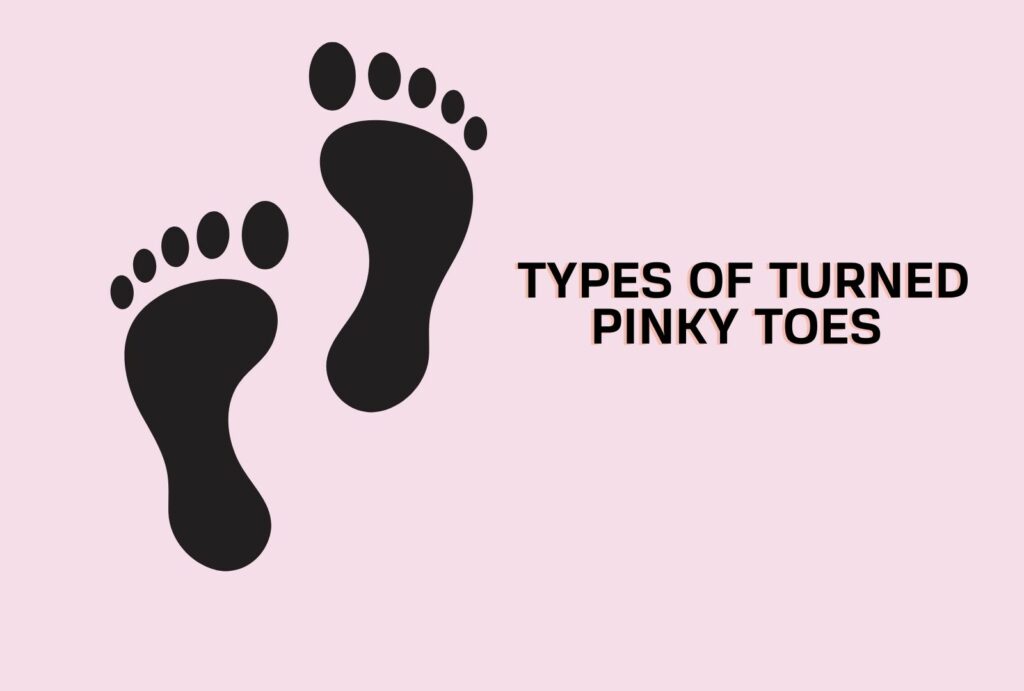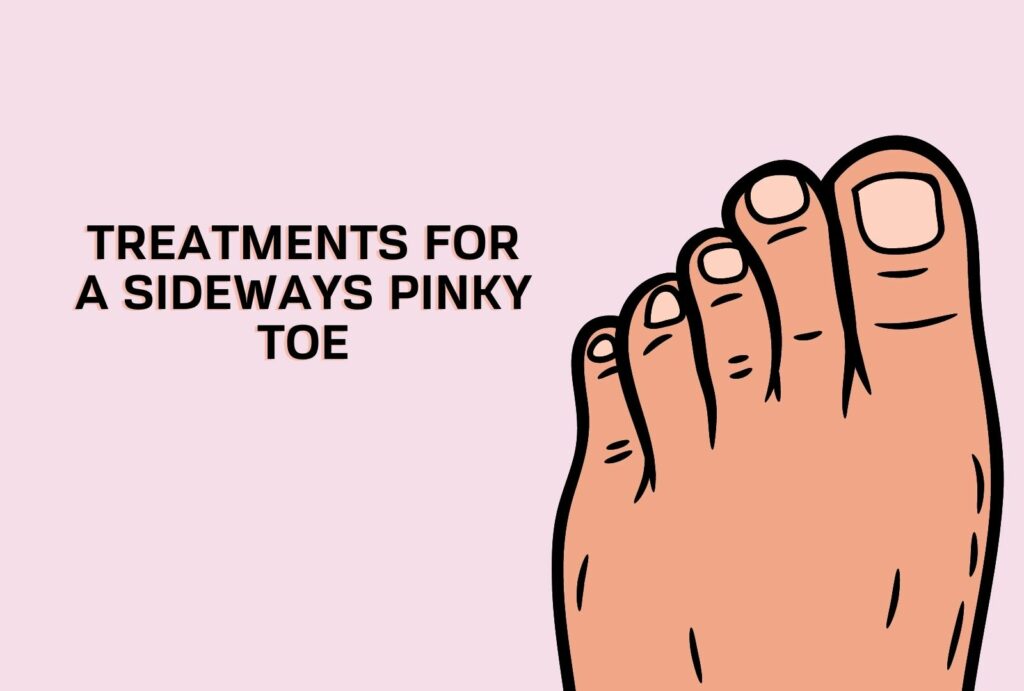
If you have noticed that your pinky toe is turning sideways, you are not alone. This condition, also known as a bunionette or tailor’s bunion, can be caused by a number of factors. Here are the four types of pinky toe turning sideways and what you can do about them:
Congenital
Some people are born with a predisposition to bunions and bunionettes. In these cases, the pinky toe may turn sideways due to a structural abnormality in the foot. If you have a congenital bunionette, you may need to wear custom orthotics or shoes to manage the condition.
Traumatic
A traumatic bunionette can occur when the foot is injured or subjected to repeated stress. This can cause the pinky toe to turn sideways due to inflammation and swelling. To manage a traumatic bunionette, it is important to rest the foot and avoid activities that exacerbate the condition.
Arthritic
Arthritis can also cause the pinky toe to turn sideways. In these cases, the joint in the pinky toe may become inflamed and swollen, leading to a deformity. Treatment for an arthritic bunionette may include medication, physical therapy, and in some cases, surgery.
Shoe-related
Wearing shoes that are too tight or narrow can also cause the pinky toe to turn sideways. This is a common issue for women who wear high heels or shoes with narrow toe boxes. To manage a shoe-related bunionette, it is important to wear shoes that fit properly and provide adequate support.
Regardless of the type of bunionette you have, there are some steps you can take to manage the condition. These include:
Wear comfortable, supportive shoes
Choose shoes that fit properly and provide adequate support for your feet. Look for shoes with a wide toe box that allow your toes to move freely.
Use padding
Use padding or a toe spacer to help keep your toes in the correct position. This can also help to relieve pressure and reduce pain.
Apply ice
If you experience pain or inflammation, apply ice to the affected area to reduce swelling.
Stretch and strengthen
Stretching and strengthening exercises can help to improve the flexibility and strength of your feet, reducing the likelihood of developing bunions and bunionettes.
Consider surgery
In some cases, surgery may be necessary to correct a severe bunionette. Talk to your healthcare provider to determine if surgery is a viable option for you.
In conclusion, a pinky toe turning sideways can be caused by a number of factors, including congenital abnormalities, trauma, arthritis, and shoe-related issues. To manage the condition, it is important to wear comfortable, supportive shoes, use padding or a toe spacer, apply ice, stretch and strengthen, and consider surgery if necessary.
Is your pinky toe being turned sideways a cause for concern?
If you have noticed that your pinky toe is turning sideways, you may be wondering if it is a cause for concern. In most cases, a pinky toe turning sideways is not a serious issue and can be managed with proper care and treatment. However, there are some cases where this condition may be a sign of an underlying problem.
In general, a pinky toe turning sideways can be caused by a number of factors, including congenital abnormalities, trauma, arthritis, and shoe-related issues. While these factors are not usually a cause for concern, they can cause discomfort and pain, making it difficult to walk or perform everyday activities.
If you are experiencing pain or discomfort due to a pinky toe turning sideways, it is important to seek medical attention. Your healthcare provider can assess the severity of your condition and recommend the best course of treatment. In some cases, surgery may be necessary to correct a severe bunionette.
In addition to causing discomfort and pain, a pinky toe turning sideways can also lead to other problems. For example, if the bunionette is not managed properly, it can become infected, leading to further complications. Additionally, if the bunionette is caused by a more serious underlying condition, such as arthritis, it is important to manage the condition to prevent further damage to the joint.
In conclusion, while a pinky toe turning sideways is not usually a cause for concern, it can cause discomfort and pain, making it difficult to walk or perform everyday activities. If you are experiencing pain or discomfort, it is important to seek medical attention to determine the underlying cause and recommend the best course of treatment. By managing the condition properly, you can reduce the risk of further complications and improve your quality of life.
Types of turned pinky toes

A pinky toe turning sideways can take different forms, and the severity can vary from person to person. The following are some of the most common types of turned pinky toes:
Bunionette
A bunionette is a bony bump that forms on the outside of the foot at the base of the pinky toe. This condition is often caused by tight-fitting shoes or an inherited foot structure. As the bony bump grows, it can cause the pinky toe to turn sideways, causing pain and discomfort.
Hammer toe
A hammer toe is a deformity that causes the middle joint of the toe to bend downward, while the tip of the toe points upward. This condition can be caused by wearing shoes that are too tight or high heels, and it can cause the pinky toe to turn sideways.
Claw toe
A claw toe is a deformity that causes the toe to bend upward at the first joint and downward at the second joint. This condition can be caused by nerve damage or wearing shoes that are too tight. A claw toe can also cause the pinky toe to turn sideways.
Mallet toe
A mallet toe is a deformity that causes the tip of the toe to bend downward, while the rest of the toe is straight. This condition can be caused by wearing shoes that are too tight or by a toe injury. A mallet toe can also cause the pinky toe to turn sideways.
In conclusion, a pinky toe turning sideways can take different forms, and the severity can vary from person to person. The most common types of turned pinky toes are bunionettes, hammer toes, claw toes, and mallet toes. These conditions can be caused by various factors, including tight-fitting shoes, inherited foot structure, nerve damage, and toe injuries. If you are experiencing pain or discomfort due to a turned pinky toe, it is important to seek medical attention to determine the underlying cause and recommend the best course of treatment.
Causes for pinky toe turning sideways
A pinky toe turning sideways can be caused by various factors, including genetics, foot structure, and footwear. Here are some of the most common causes:
Genetics
A person’s foot structure is largely determined by their genes. If a person’s parents or grandparents had a pinky toe that turned sideways, it is likely that they will also develop this condition.
Foot structure
Even if a person does not have a genetic predisposition to a turned pinky toe, their foot structure can still play a role. For example, if a person has flat feet or high arches, they may be more prone to developing a pinky toe that turns sideways.
Footwear
Wearing shoes that are too tight or too narrow can put pressure on the toes, causing them to deform over time. High heels are also a common culprit, as they can force the toes forward and cramp them into a small space.
Foot injuries
Trauma to the foot, such as a fracture or sprain, can cause the bones and ligaments to shift, leading to a pinky toe that turns sideways.
Neurological conditions
Certain neurological conditions, such as cerebral palsy, can cause muscle weakness or spasticity in the feet, leading to a pinky toe that turns sideways.
In conclusion, a pinky toe turning sideways can be caused by various factors, including genetics, foot structure, footwear, foot injuries, and neurological conditions. While some of these causes are outside a person’s control, others can be prevented by wearing proper-fitting shoes and practicing good foot care. If a person is experiencing pain or discomfort due to a turned pinky toe, they should seek medical attention to determine the underlying cause and recommend the best course of treatment.
Treatments for a sideways pinky toe

Treatment for a sideways pinky toe will depend on the underlying cause and the severity of the condition. Here are some of the most common treatments:
Toe pads and splints
Toe pads can be placed under the affected toe to help redistribute pressure and prevent it from rubbing against other toes. Splints can also be used to help straighten the toe over time.
Shoe modifications
Wearing shoes with a wider toe box or open-toed shoes can help relieve pressure on the toe and prevent it from turning sideways. Avoiding high heels and shoes with pointed toes is also recommended.
Physical therapy
In cases where a sideways pinky toe is caused by a foot injury or neurological condition, physical therapy may be recommended to improve foot strength and flexibility.
Surgery
In severe cases where other treatments have not been effective, surgery may be necessary to correct the alignment of the toe. This can involve removing part of the bone, realigning the ligaments, or fusing the joint.
Lifestyle changes
Making lifestyle changes such as maintaining a healthy weight, wearing proper-fitting shoes, and avoiding high-impact activities that can put stress on the feet can help prevent a sideways pinky toe from getting worse.
It is important to note that treatment for a sideways pinky toe is not always necessary, especially if it is not causing any pain or discomfort. However, if the condition is causing pain or difficulty walking, it is recommended to seek medical attention to determine the underlying cause and recommend the best course of treatment.
In conclusion, treatment for a sideways pinky toe will depend on the underlying cause and severity of the condition. Toe pads, shoe modifications, physical therapy, surgery, and lifestyle changes are all potential treatments. If a person is experiencing pain or difficulty walking due to a sideways pinky toe, they should seek medical attention to determine the best course of treatment.